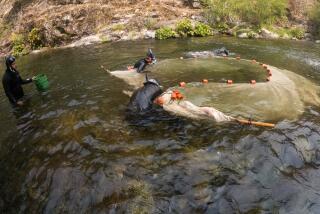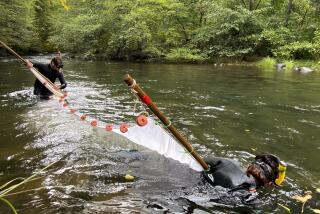The Reviving of an Ailing Fishery : Hoping to Reverse Trend, Volunteers Fertilize Lake Mead
- Share via
ECHO BAY MARINA, Nev. — A hot evening wind blew off Lake Mead, rattling the dry palm fronds on the grounds of the little hotel.
On a shaded, second-floor porch, bass fishermen and volunteer workers looked out upon the Overton Arm of Lake Mead and discussed a project they hoped would help reverse the decline of sportfishing on Lake Mead, once one of western America’s top sportfishing destinations.
“Every so often, I’ll catch a bass that has its lips all cut up and torn,” fisherman Don Sollberger said. “The reason for that is that they’re rooting around in loose rock and gravel, trying to find crayfish. That means they can’t find shad. It’s a bad sign.”
Even more graphic evidence of Mead’s sportfishing slump is the size and abundance of largemouth bass caught in Mead over the last two decades. From a high of 800,000 largemouth bass caught in 1963, the catch count--an estimate, based on creel checks by the Nevada Department of Wildlife--had dropped steadily to about 200,000 catches a year by 1976, where it remains today.
Mead’s striped bass and rainbow trout fisheries are similarly depleted. In the late 1970s, catches of fat stripers in the 30-pound class were common. Fishermen who fished all night to avoid the 115-degree daytime heat could catch and release 50 to 100 stripers.
Today, however, Mead’s stripers look more like eels than healthy game fish.
But one recent weekend, 1,100 volunteers--many of them fishermen desiring to help Mead become again what it once was--gathered at Echo Bay Marina to participate in the largest lake fertilization project ever attempted in North America.
To be sure, it was a unique spectacle. In 300 boats, each carrying an average of 70 gallons of ammonium polyphosphate in five-gallon plastic jugs, the army of volunteers poured about 20,000 gallons of the chemical--basically the same kind of fertilizer farmers put on their crops--into a 10 x 3-mile area of the lake’s Overton Arm.
Phosphates are the bottom link in Mead’s food chain, and its missing element. Theoretically, the added phosphates will increase the growth of algae, which will spur growth of zooplankton, which will provide a food source for juvenile threadfin shad, the prime food source of largemouth and striped bass, and, to a lesser extent, rainbow trout.
“Trying to grow game fish in a lake with low phosphate levels is like trying to grow cows on a beach,” said Larry Paulson, the University of Nevada Las Vegas limnologist who directed the project. Limnology is the science concerned with the physical, chemical and biological properties of freshwater.
So what happened to Mead’s phosphate levels?
“When Glen Canyon Dam (the dam that holds up Lake Powell, 200 miles upstream on the Colorado River) was completed in 1963, the natural flow of phosphates down the Colorado to Mead was interrupted,” Paulson said.
Paulson pointed out that the phosphates being blocked by Glen Canyon Dam, 200 miles upstream, weren’t missed in Mead for years, since the 150 x 50-mile reservoir had another source of phosphate-rich water--the outflow of the Clark County advanced waste water treatment plant in Las Vegas.
However, stiffer environmental laws in the late 1970s required phosphate levels in the water coming out of the plant to be dropped from 5 parts per million to 1. Result: Mead’s game fish found themselves in thin soup.
Although creel checks show a steady decline of largemouth bass fishing in Mead since 1963, Sollberger, a pro bass fisherman, says the decline just in recent years has been dramatic.
“In tournaments out here, the fish we were catching in 1981 were averaging about three pounds,” he said. “Now, it’s around a pound and a half, maybe two pounds, if you can find any. My kids, six or eight years ago, could go running around the rocky, shallow water areas and bring back a bucket full of crawdads. Now, you can hardly find any.
“Mead is hurting. And I feel like a lot of us here this weekend--if we can bring Mead back to what it once was, so our kids will one day have the kind of fishing we once did, it’ll be worth it.”
Joe Burns, general manager of Echo Bay Marina, about 75 miles from Las Vegas, said that many bass fishermen have given up on Mead.
“When I first came here, in 1979, about 75% or 80% of our customers were fishermen,” he said. “Now, it’s less than 5%. We’re mostly a resort for water-skiers now.”
The fertilization is actually a long-term project.
“Right now, we’re looking at doing this every year,” Paulson said. “Our expectations are that at the end of the first year, we should be seeing a little bump-up in the threadfin shad population. By the second year, we would expect to see a measurable increase in the shad, and by the third year, significantly improved condition of the striped and largemouth bass fisheries.
“(Fertilization) is something that would probably have to be done on a yearly basis, unless we can get raised phosphate levels in the treated water coming out of the sewage treatment plant.”






